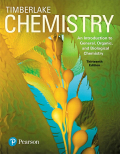
Chemistry: An Introduction to General Organic and Biological Chemistry (13th Edition)
13th Edition
ISBN: 9780134564586
Author: Timberlake
Publisher: PEARSON
expand_more
expand_more
format_list_bulleted
Concept explainers
Question
Chapter 18.6, Problem 18.54PP
Interpretation Introduction
To describe: Why FADH2 yield 1.5 ATP, using the electron transport system, but NADH yields 2.5 ATP.
Expert Solution & Answer
Want to see the full answer?
Check out a sample textbook solution
Students have asked these similar questions
Draw the mechanism for the formation of diol by starting with one pen and all in...
basic conditions
then
acidic conditions
then draw the mechanism for the formation of a carboxylic acid from your product.
Draw the mechanism for the oxidation of 3-bromo-cyclohexan-1-ol.
Convert the following Fischer projection to Haworth projections. show work and show the arrows please.
Chapter 18 Solutions
Chemistry: An Introduction to General Organic and Biological Chemistry (13th Edition)
Ch. 18.1 - Prob. 18.1PPCh. 18.1 - Prob. 18.2PPCh. 18.1 - Prob. 18.3PPCh. 18.1 - Prob. 18.4PPCh. 18.1 - Prob. 18.5PPCh. 18.1 - Prob. 18.6PPCh. 18.2 - Prob. 18.7PPCh. 18.2 - Prob. 18.8PPCh. 18.2 - Prob. 18.9PPCh. 18.2 - Prob. 18.10PP
Ch. 18.2 - Prob. 18.11PPCh. 18.2 - Prob. 18.12PPCh. 18.3 - Prob. 18.13PPCh. 18.3 - Prob. 18.14PPCh. 18.3 - Prob. 18.15PPCh. 18.3 - Prob. 18.16PPCh. 18.3 - Prob. 18.17PPCh. 18.3 - Prob. 18.18PPCh. 18.4 - Prob. 18.19PPCh. 18.4 - Prob. 18.20PPCh. 18.4 - Prob. 18.21PPCh. 18.4 - Prob. 18.22PPCh. 18.4 - Prob. 18.23PPCh. 18.4 - Prob. 18.24PPCh. 18.4 - Prob. 18.25PPCh. 18.4 - Prob. 18.26PPCh. 18.4 - Prob. 18.27PPCh. 18.4 - Prob. 18.28PPCh. 18.4 - Prob. 18.29PPCh. 18.4 - Prob. 18.30PPCh. 18.4 - Prob. 18.31PPCh. 18.4 - Prob. 18.32PPCh. 18.4 - Prob. 18.33PPCh. 18.4 - Prob. 18.34PPCh. 18.5 - Prob. 18.35PPCh. 18.5 - Prob. 18.36PPCh. 18.5 - Prob. 18.37PPCh. 18.5 - Prob. 18.38PPCh. 18.5 - Prob. 18.39PPCh. 18.5 - Prob. 18.40PPCh. 18.5 - Prob. 18.41PPCh. 18.5 - Prob. 18.42PPCh. 18.6 - Prob. 18.43PPCh. 18.6 - Prob. 18.44PPCh. 18.6 - Prob. 18.45PPCh. 18.6 - Prob. 18.46PPCh. 18.6 - Prob. 18.47PPCh. 18.6 - Prob. 18.48PPCh. 18.6 - Prob. 18.49PPCh. 18.6 - Prob. 18.50PPCh. 18.6 - Prob. 18.51PPCh. 18.6 - Prob. 18.52PPCh. 18.6 - Prob. 18.53PPCh. 18.6 - Prob. 18.54PPCh. 18.6 - Prob. 18.55PPCh. 18.6 - Prob. 18.56PPCh. 18.7 - Prob. 18.57PPCh. 18.7 - Prob. 18.58PPCh. 18.7 - Prob. 18.59PPCh. 18.7 - Prob. 18.60PPCh. 18.7 - Prob. 18.61PPCh. 18.7 - Prob. 18.62PPCh. 18.7 - Prob. 18.63PPCh. 18.7 - Prob. 18.64PPCh. 18.8 - 18.65 Draw the condensed structural formula for...Ch. 18.8 - 18.66 Draw the condensed structural formula for...Ch. 18.8 - 18.67 Why does the body convert NH4+ to urea?
Ch. 18.8 - Prob. 18.68PPCh. 18.8 - Prob. 18.69PPCh. 18.8 - Prob. 18.70PPCh. 18.8 - Draw the condensed structural formulas for the...Ch. 18.8 - Prob. 18.72PPCh. 18 - Prob. 18.73UTCCh. 18 - Prob. 18.74UTCCh. 18 - Prob. 18.75UTCCh. 18 - Prob. 18.76UTCCh. 18 - Prob. 18.77APPCh. 18 - Prob. 18.78APPCh. 18 - Prob. 18.79APPCh. 18 - Prob. 18.80APPCh. 18 - Prob. 18.81APPCh. 18 - Prob. 18.82APPCh. 18 - Prob. 18.83APPCh. 18 - Prob. 18.84APPCh. 18 - Prob. 18.85APPCh. 18 - Prob. 18.86APPCh. 18 - Prob. 18.87APPCh. 18 - Prob. 18.88APPCh. 18 - Prob. 18.89APPCh. 18 - Prob. 18.90APPCh. 18 - Prob. 18.91APPCh. 18 - Prob. 18.92APPCh. 18 - Prob. 18.93CPCh. 18 - Prob. 18.94CPCh. 18 - Prob. 18.95CPCh. 18 - Prob. 18.96CPCh. 18 - Prob. 18.97CPCh. 18 - Prob. 18.98CPCh. 18 - Prob. 33CICh. 18 - CI.34 In response to signals from the nervous...Ch. 18 - Prob. 35CICh. 18 - Prob. 36CICh. 18 - Prob. 37CICh. 18 - Prob. 38CICh. 18 - Prob. 39CICh. 18 - Thalassemia is an inherited genetic mutation that...
Knowledge Booster
Learn more about
Need a deep-dive on the concept behind this application? Look no further. Learn more about this topic, chemistry and related others by exploring similar questions and additional content below.Similar questions
- Draw the mechanism for the substitution reaction converting an alcohol into an alkyl halide. If chirality is important to the reaction include it.arrow_forwardWrite, in words three different reactions we can use to make an alcohol.arrow_forwardDraw the reduction mechanism for the reduction of the aldehyde.arrow_forward
- What is the product of the reaction of XeF4 with H2O? Group of answer choices H2XeF2 H2XeF4 XeO3 H2XeOarrow_forwardWhile noble gas exerts the strongest London (dispersion) forces on neighboring atoms? Group of answer choices Xe Ar Kr Nearrow_forwardWhich of the following elements is corrosive to your skin due to that element breaking down C=C bonds? Group of answer choices fluorine iodine bromine chlorinearrow_forward
arrow_back_ios
SEE MORE QUESTIONS
arrow_forward_ios
Recommended textbooks for you
 ChemistryChemistryISBN:9781305957404Author:Steven S. Zumdahl, Susan A. Zumdahl, Donald J. DeCostePublisher:Cengage Learning
ChemistryChemistryISBN:9781305957404Author:Steven S. Zumdahl, Susan A. Zumdahl, Donald J. DeCostePublisher:Cengage Learning ChemistryChemistryISBN:9781259911156Author:Raymond Chang Dr., Jason Overby ProfessorPublisher:McGraw-Hill Education
ChemistryChemistryISBN:9781259911156Author:Raymond Chang Dr., Jason Overby ProfessorPublisher:McGraw-Hill Education Principles of Instrumental AnalysisChemistryISBN:9781305577213Author:Douglas A. Skoog, F. James Holler, Stanley R. CrouchPublisher:Cengage Learning
Principles of Instrumental AnalysisChemistryISBN:9781305577213Author:Douglas A. Skoog, F. James Holler, Stanley R. CrouchPublisher:Cengage Learning Organic ChemistryChemistryISBN:9780078021558Author:Janice Gorzynski Smith Dr.Publisher:McGraw-Hill Education
Organic ChemistryChemistryISBN:9780078021558Author:Janice Gorzynski Smith Dr.Publisher:McGraw-Hill Education Chemistry: Principles and ReactionsChemistryISBN:9781305079373Author:William L. Masterton, Cecile N. HurleyPublisher:Cengage Learning
Chemistry: Principles and ReactionsChemistryISBN:9781305079373Author:William L. Masterton, Cecile N. HurleyPublisher:Cengage Learning Elementary Principles of Chemical Processes, Bind...ChemistryISBN:9781118431221Author:Richard M. Felder, Ronald W. Rousseau, Lisa G. BullardPublisher:WILEY
Elementary Principles of Chemical Processes, Bind...ChemistryISBN:9781118431221Author:Richard M. Felder, Ronald W. Rousseau, Lisa G. BullardPublisher:WILEY

Chemistry
Chemistry
ISBN:9781305957404
Author:Steven S. Zumdahl, Susan A. Zumdahl, Donald J. DeCoste
Publisher:Cengage Learning

Chemistry
Chemistry
ISBN:9781259911156
Author:Raymond Chang Dr., Jason Overby Professor
Publisher:McGraw-Hill Education

Principles of Instrumental Analysis
Chemistry
ISBN:9781305577213
Author:Douglas A. Skoog, F. James Holler, Stanley R. Crouch
Publisher:Cengage Learning

Organic Chemistry
Chemistry
ISBN:9780078021558
Author:Janice Gorzynski Smith Dr.
Publisher:McGraw-Hill Education

Chemistry: Principles and Reactions
Chemistry
ISBN:9781305079373
Author:William L. Masterton, Cecile N. Hurley
Publisher:Cengage Learning

Elementary Principles of Chemical Processes, Bind...
Chemistry
ISBN:9781118431221
Author:Richard M. Felder, Ronald W. Rousseau, Lisa G. Bullard
Publisher:WILEY